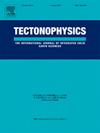Late Pleistocene thrust tectonics in the north Peruvian forearc revealed by Terrestrial Cosmogenic Nuclides surface exposure dating, field structural data and seismic profiles
IF 2.6
3区 地球科学
Q2 GEOCHEMISTRY & GEOPHYSICS
引用次数: 0
Abstract
Precise dating of geomorphic markers that are subject to thrust-related deformation, such as alluvial fan surface are crucial for quantifying forearc deformation, especially in a context of weak interseismic coupling on the subduction interface as in northern Peru. In this study, we document the late Pleistocene tectonic history of the Amotape massif, which is a prominent basement relief in the northern Peruvian forearc. To achieve this, we combine a morphometric analysis and Terrestrial Cosmogenic Nuclides (TCNs) surface exposure dating of alluvial fan surface with subsurface structural data. TCNs (10Be and 26Al) surface exposure ages of alluvial fan surfaces on the northwestern flank of the massif range from 35.1 ± 1.1 ka to 59.3 ± 2.1 ka for 10Be and from 27.3 ± 2.0 ka to 48.9 ± 2.5 ka for 26Al. Both cosmogenic nuclides provide consistent results. We calculated a mean weighted age of 39.0 ± 0.3 ka for an alluvial fan that is offset by a major NW-verging thrust. Our results provide an estimated slip rate of 1.15 ± 0.46 m/ka along the Amotape thrust front since the late Pleistocene. The surface deformation along the Amotape thrust front correlates with the top portion of a deep-seated contractional wedge involving the crustal basement, according to subsurface structural data and regional seismicity. This integrated analysis demonstrates active shortening in the onshore crustal basement of the northern Peruvian forearc where no active thrust reaching the surface has been described before.

陆生核素地表暴露测年、野外构造资料和地震剖面揭示的秘鲁北部前弧晚更新世逆冲构造
受逆冲相关变形影响的地貌标志(如冲积扇表面)的精确测年对于量化弧前变形至关重要,特别是在秘鲁北部这样的俯冲界面上地震间耦合较弱的背景下。在本研究中,我们记录了秘鲁北部前弧中一个突出的基底凸起——Amotape地块的晚更新世构造史。为了实现这一目标,我们将冲积扇表面的形态计量学分析和陆地宇宙成因核素(TCNs)表面暴露测年与地下结构数据相结合。山体西北侧冲积扇表面TCNs (10Be和26Al)暴露年龄为35.1±1.1 ka ~ 59.3±2.1 ka, 26Al表面TCNs暴露年龄为27.3±2.0 ka ~ 48.9±2.5 ka。这两种宇宙核素提供了一致的结果。我们计算出一个冲积扇的平均加权年龄为39.0±0.3 ka,该冲积扇被一个主要的北西向逆冲冲断所抵消。结果表明,自晚更新世以来,阿莫塔普冲断前缘的滑动速率估计为1.15±0.46 m/ka。根据地下构造资料和区域地震活动性,阿莫塔夫冲断前缘的地表变形与一个涉及地壳基底的深部收缩楔的顶部有关。这一综合分析表明,秘鲁北部前弧的陆上地壳基底活动缩短,在此之前没有描述过到达地表的活动冲断。
本文章由计算机程序翻译,如有差异,请以英文原文为准。
求助全文
约1分钟内获得全文
求助全文
来源期刊

Tectonophysics
地学-地球化学与地球物理
CiteScore
4.90
自引率
6.90%
发文量
300
审稿时长
6 months
期刊介绍:
The prime focus of Tectonophysics will be high-impact original research and reviews in the fields of kinematics, structure, composition, and dynamics of the solid arth at all scales. Tectonophysics particularly encourages submission of papers based on the integration of a multitude of geophysical, geological, geochemical, geodynamic, and geotectonic methods
 求助内容:
求助内容: 应助结果提醒方式:
应助结果提醒方式:


